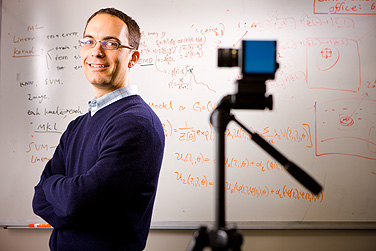Close Up
Corso’s computer vision of the future

Jason Corso’s goal is to build a computer system that can perform as well as a human in image-understanding tasks. Photo: DOUGLAS LEVERE
It all began with the Commodore 64, the 8-bit home computer of the 1980s that plugged into the family TV set, opening Jason Corso’s 6-year-old eyes to the possibilities of computers. Now some 25 years later, he is pushing the boundaries of computer vision into remarkable human-like interactions in a broad span of life-enhancing areas.
The assistant professor joined the computer science and engineering faculty in the School of Engineering and Applied Sciences in 2007, recruited under the UB 2020 strategic strength of Information and Computing Technology and its Smart Environments initiative that facilitates accelerated research in interactive computing.
Such complex interaction compels Corso’s research and his unbridled enthusiasm to realize a sci-fi-like future of robots popping up alongside highways to attend to accident scenes or picking out the terrorist and anticipating imminent danger for military personnel.
“This is all computer vision and reasoning—a potential that we can realize within 20 years,” observes Corso. “Sci-fi is upon us. If you like technology, this is a nice time to live. It’s like being an alchemist in medieval Europe, except what we’re realizing is actually there to realize.”
Corso’s quest is to build a computer system that can perform as well as a human in image-understanding tasks. “That’s the holy grail of computer vision,” he says. “If we can build a system that can really do that, we can do almost anything. To get it to work in the real world is my end goal.”
To achieve that end, the young scientist is rising fast in the field. In his three years at UB, Corso has won the prestigious National Science Foundation CAREER award in 2009, was recognized as a “visionary innovator” by UB in 2010, has generated $4.5 million of active funding and heads a growing research team of nearly 20 members.
In his high-level imaging science, Corso is developing better mathematical models and computational methods of representing and searching content in images and videos. One goal is to turn the phrases that people use to describe images into codes that computers can comprehend. This research can have an incredible impact on a wide range of areas—from health care to military intelligence to advanced emergency-response systems.
Corso has found an environment at UB that is conducive to collaboration and discovery. “Through interactions and my own outreach when I first got here, I found a very welcoming group in philosophy and biomedicine and so on,” he relates. “I was really taken with ontology. Unexpectedly, I found that UB is THE place in the U.S. for ontology research. I didn’t know anything about ontology before I came here. It had an impact on my thinking and my approach to computational problems.”
With his new-found interest, Corso went about building a research direction on what he calls “mathematicizing” ontologists—finding the glue that can marry the formal rigor of a good philosophical ontology with concrete mathematics and computational science. “Nowhere in the U.S. could this have happened,” he says. “I met these very intelligent and open people, and learned an awful lot from them.”
Corso has been drawn to the visual world ever since the childhood gift (which he still has), writing computer programs and creating on the Commodore 64. “It was kind of the flip of a coin whether I would pursue a career in computing or in creative writing,” he recalls. “As an undergraduate (at Loyola College in Baltimore), my mentor asked, ‘How are you going to combine your love of creating with your abilities in math and computing?’ This has been a full realization of that question.”
The Queens, N.Y., native lives in Buffalo with his wife, Aileen, a mathematician and educational analyst; daughter Honora, 3½ and son Isaac, 6 months.
Corso indicates he can even see an evolution of his research in the interactions of his children as they learn words, providing him insight into why ontology and semantics are important for visual reasoning and how humans organize information.
“We live in an old house in the city with four fireplaces. Honora was sitting underneath the fireplace mantle getting warm one night and she looked up and asked, ‘What is this thing”? I gave her the word ‘mantle.’ For her, a mantle was something that covered her head and under it was a warm, safe place. Two days later, she was sitting underneath the table in the kitchen near the edge and said, ‘Look, Daddy, it’s a mantle.’ That was really enlightening. She was using function as a key descriptor in her organization of the world. I would come into class and relate the next thing that was learned by Honora about the visual world and how that impacted my lecture. It was very exciting.”

Reader Comments